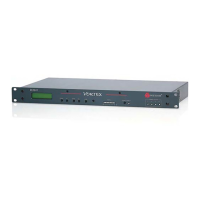29
Inputs 1-3 need to be assigned to Output A to feed the left channel of the VSX 8000. Input 4 will be
assigned to Outputs A and B at -3 dB since it is considered a center mic. By assigning a
crosspoint attenuation of -3 dB, the level from the microphone when reproduced on the far end
will be about the same as the left or right side microphones.
The channel separation is shown via the Input A to Output D and Input B to Output C crosspoints
as well as the Input A to R2 and Input B to R1 crosspoints. These crosspoints must have the same
value in order for the Vortex AEC to be able to track both left and right channels of audio. If the
channel separation needs to be raised from -10, then all four crosspoints will need to be changed
to the new value.
Inputs C and D are attenuated by 3 dB to Outputs R1 and R2 to account for a stereo signal being
routed to a mono output. Since the two signals may not be correlated (i.e. have no time
relationship between each other), then when they are added together, the summed signal will be
+3 dB higher.
In this example, we will assume that the VSX 8000, program audio, and amplifier are designed to
send and/or receive a professional level signal. Therefore, Inputs A, B, C, and D and Outputs A, B,
C, and D will be set to 0 dB. For more information as to the reasoning behind the gain levels,
please see the Gain Structure for Amplifiers and Other Sources page.
Local Microphones should NEVER be included the reference signal!

